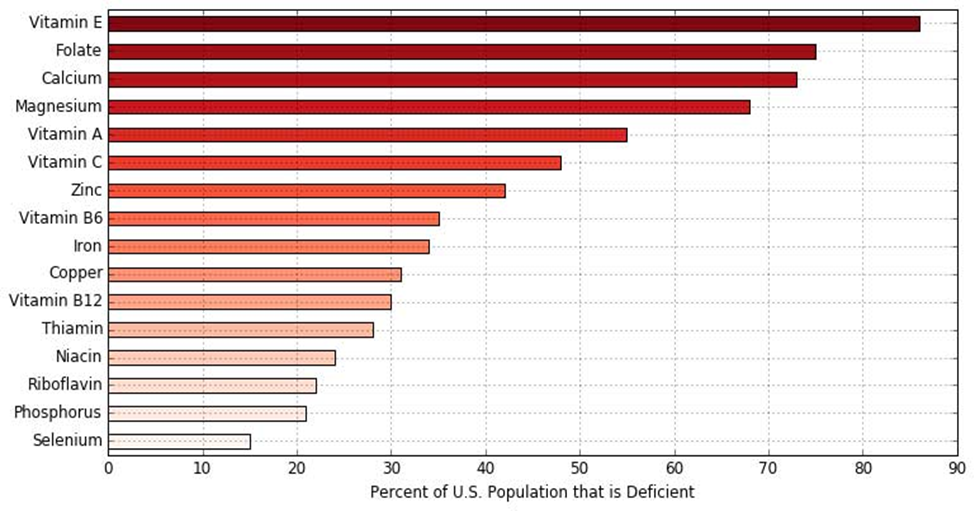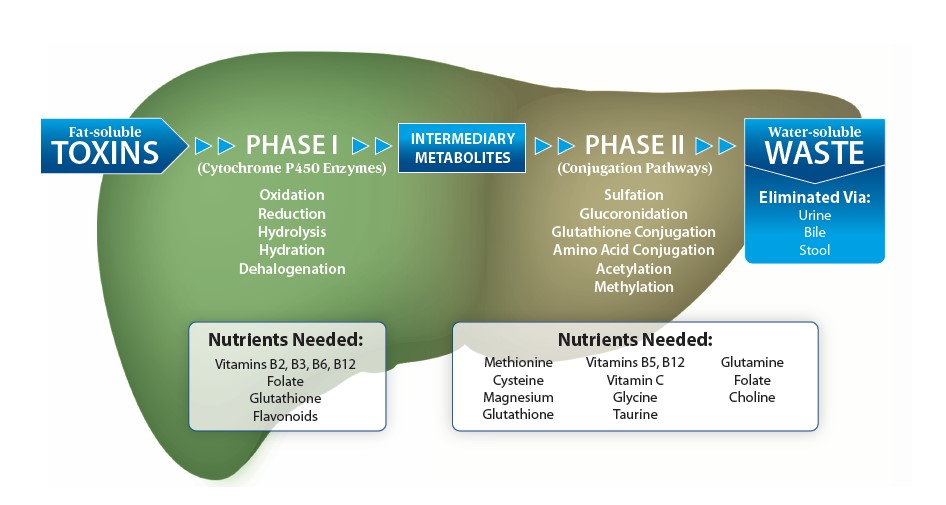Some of the side effects reported from the use of hormone products include fatigue, mood changes, weight gain and decreased libido. What if those side effects are a result of how the body breaks down those medications?
Many of the top 200 prescription drugs on the market can cause drug-induced nutrient depletion (DIND). Included in that list are birth control and hormone replacement medications. Additional nutrient losses are often not replaced by the Standard American Diet (SAD), and most Americans are already low in many nutrients even without DIND as a complicating factor.
See the graph below on the percentages of Americans with nutrient deficiencies.

Key vitamins and minerals and the estimated percentage of the US population deficient in them. (Source: US Department of Agriculture, 2009)
How Hormones Cause Drug-Induced Nutrient Depletion
Our bodies require different nutrients for the liver to utilize and break down estrogens and other hormones. These nutrients are used in chemical reactions to prepare hormones to safely leave the body. If your patients take hormones every day for birth control, post-menopausal symptoms or other purposes, they also then use extra nutrients daily. For someone who is already low in those nutrients, medications can cause further nutrient depletion.
See the following image on nutrients used in Phase 1 and Phase 2 processes that the liver employs to detoxify hormones and other compounds in the body.

How DIND Impacts Energy and Neurotransmitters
Many of the nutrients used in the liver for detoxification are also used for other purposes. When multiple systems require sufficient levels of the same nutrients, a wide range of issues may occur from nutrient depletion.
B vitamins, folate and magnesium are especially vital for energy production. It is no wonder then that many patients complain of low energy after starting hormone therapy. The following nutrients and amino acids, which are required for the previously mentioned processes in the liver, are also used for energy and neurotransmitter production:
- B Vitamins: B2, B3, B5, B6 and B12
- Vitamin C
- Folate
- Magnesium
- Amino Acids
- Methionine
- Cysteine
- Glycine
- Taurine
- Glutamine
- Choline
The chart below lists some essential neurotransmitters, their general role and the unwelcome symptoms that may appear in deficient patients.
| Neurotransmitter | Role | Deficiency Symptoms |
|---|---|---|
| Serotonin | Mood and happiness | Depression |
| GABA | Calm and focus | Anxiety |
| Dopamine | Pleasure and motivation | Low motivation or addiction |
| Acetylcholine | Learning | Difficulty learning |
| Glutamate | Memory | Poor memory |
| Noradrenaline | Concentration | Difficultly concentrating |
DIND Treatment Tips
With proper nutritional intervention, patients can keep taking their birth control or hormone replacement prescriptions. A treatment protocol may include replacing the nutrients depleted by the hormones they are taking alongside dietary improvements.
- Prescribe a professional-grade multivitamin for them to take twice a day.
- Over-the-counter, once-a-day vitamins do not contain nearly enough B vitamins.
- I recommend against gummy vitamins for the same reason: They are poorly made and often contain only small doses of vitamins.
- I may additionally recommend adding a professional-grade B complex vitamin to a patient’s daily regimen.
- Remember, B vitamins boost energy, so it is important to not take them in the evening.
- Encourage your patients to eat more brightly colored vegetables and dark leafy greens because they are full of diverse vitamins and minerals.
- Patients should eat more protein to replace the amino acids that form neurotransmitters.
- Eat or drink 60-100 mg of lean-source protein.
- Lean protein also helps maintain feelings of fullness, decrease carbohydrate cravings and reduce weight gain.
Hopefully, your patients will have more energy and feel brighter soon after these interventions. Good luck through good nutrition!

Jeff Robins, RPh is a national and international speaker, teacher and consultant. Jeff speaks on functional medicine, nutrition and the business of functional medicine. He and his wife Stacy previously owned Essential Wellness Pharmacy, an
award-winning pharmacy, and Optimum Health Solutions, a corporate wellness business. Both companies were designed to empower patients to live their lives to the fullest.
References
- US Department of Health and Human Services and US Department of Agriculture. 2015-2020 Dietary Guidelines for Americans. December 2015. Available at: https://health.gov/dietaryguidelines/2015/.
- Huskisson E, Maggini S, Ruf M. The role of vitamins and minerals in energy metabolism and well-being. J Int Med Res. 2007;35(3):277-289.
- Fulgoni VL, 3rd, Keast DR, Bailey RL, Dwyer J. Foods, fortificants, and supplements: Where do Americans get their nutrients? J Nutr. 2011;141(10):1847-1854.
- Bailey RL, Fulgoni VL, 3rd, Keast DR, Dwyer JT. Examination of vitamin intakes among US adults by dietary supplement use. J Acad Nutr Diet. 2012;112(5):657-663 e654.
- Wallace TC, McBurney M, Fulgoni VL, 3rd. Multivitamin/mineral supplement contribution to micronutrient intakes in the United States, 2007-2010. J Am Coll Nutr. 2014;33(2):94-102.
- Food and Nutrition Board, Institute of Medicine. Vitamin E. Dietary Reference Intakes for Vitamin C, Vitamin E, Selenium, and Carotenoids. Washington, D.C.: National Academy Press; 2000:186-283.
- Kerns JC, Arundel C, Chawla LS. Thiamin deficiency in people with obesity. Adv Nutr. 2015;6(2):147-153. Published 2015 Mar 13.
- Rivlin RS. Riboflavin (vitamin B2) In: Zempleni J, Rucker RB, McCormick DB, Suttie JW, eds. Handbook of Vitamins. 4th ed. CRC Press; Boca Raton, FL, USA: 2007.
- Daugherty M, Polanuyer B, Farrell M, et al. Complete reconstitution of the human coenzyme A biosynthetic pathway via comparative genomics. J Biol Chem. 2002;277(24):21431-21439.
- Huskisson E, Maggini S, Ruf M. The role of vitamins and minerals in energy metabolism and well-being. J Int Med Res. 2007;35(3):277-289.
- Depeint F, Bruce WR, Shangari N, Mehta R, O'Brien PJ. Mitochondrial function and toxicity: role of B vitamins on the one-carbon transfer pathways. Chem Biol Interact. 2006;163(1-2):113-132.
- Depeint F, Bruce WR, Shangari N, Mehta R, O'Brien PJ. Mitochondrial function and toxicity: role of the B vitamin family on mitochondrial energy metabolism. Chem Biol Interact. 2006;163(1-2):94-112.
- Wu G. Amino acids: Metabolism, functions, and nutrition. Amino Acids. 2009;37:1–17.
- Bak LK, Schousboe A, Waagepetersen HS. The glutamate/GABA-glutamine cycle: aspects of transport, neurotransmitter homeostasis and ammonia transfer. J Neurochem. 2006;98(3):641-653.
- Morris RG. NMDA receptors and memory encoding. Neuropharmacology. 2013;74:32-40.
- Albrecht J, Sidoryk-Węgrzynowicz M, Zielińska M, Aschner M. Roles of glutamine in neurotransmission. Neuron Glia Biol. 2010;6(4):263-276.
- Olney JW, Zorumski C, Price MT, Labruyere J. L-cysteine, a bicarbonate-sensitive endogenous excitotoxin. Science. 1990;248(4955):596-599.
- Ochoa-de la Paz LD, Martínez-Dávila IA, Miledi R, Martínez-Torres A. Modulation of human GABArho1 receptors by taurine. Neurosci Res. 2008;61(3):302-308.
- Dalangin R, Kim A, Campbell RE. The Role of Amino Acids in Neurotransmission and Fluorescent Tools for Their Detection. Int J Mol Sci. 2020;21(17):6197. Published 2020 Aug 27.



